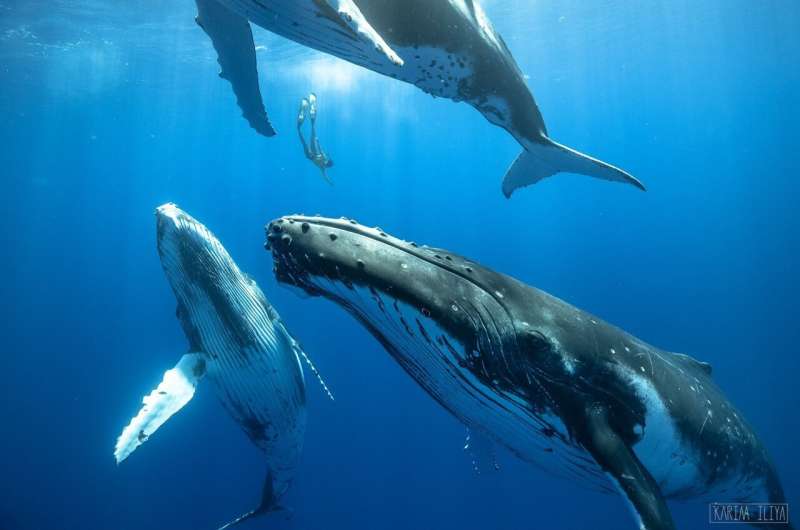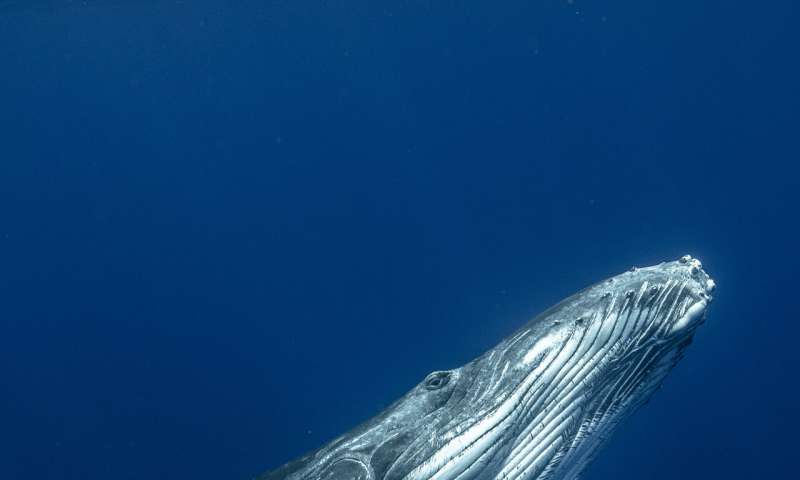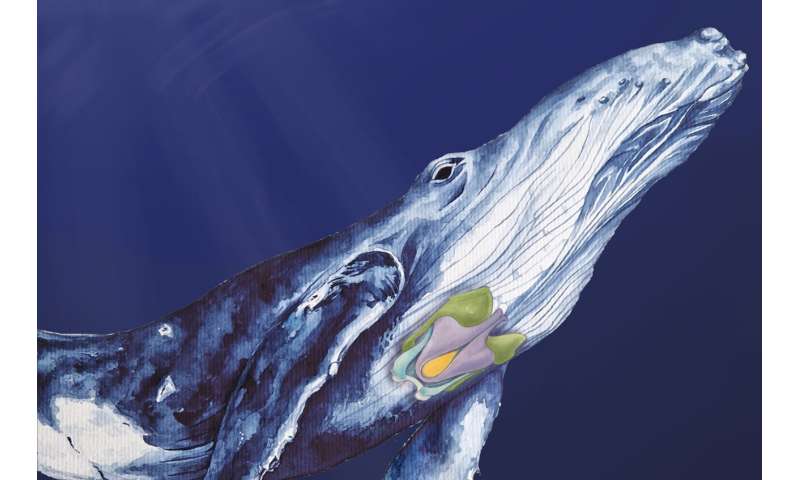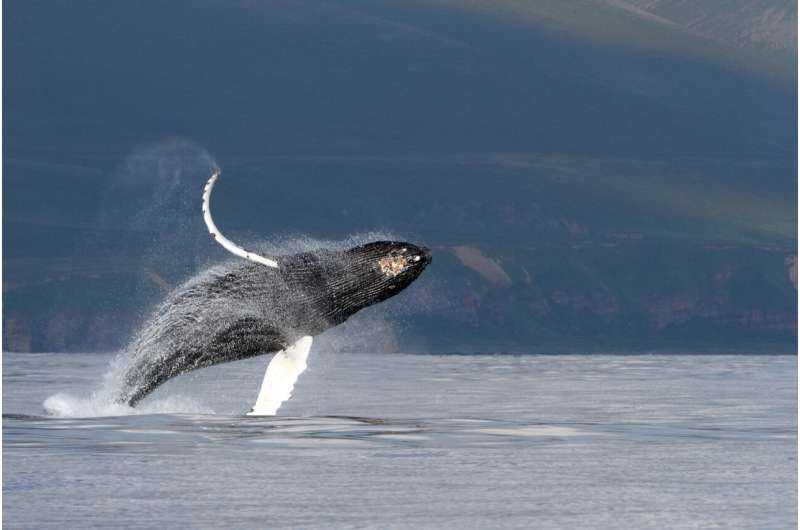This article has been reviewed according to Science X's editorial process and policies. Editors have highlighted the following attributes while ensuring the content's credibility:
fact-checked
peer-reviewed publication
trusted source
proofread
Baleen whales evolved a unique larynx to communicate but cannot escape human noise

Baleen whales are the largest animals to have ever roamed our planet and as top predators play a vital role in marine ecosystems. To communicate across vast distances and find each other, baleen whales depend critically on the production of sounds that travels far in murky and dark oceans.
However, since whale songs were first discovered more than 50 years ago, it remained unknown how baleen whales produce their complex vocalizations—until now.
A new study in Nature reports that baleen whales evolved unique structures in their larynx that enable their low-frequency vocalizations, but also limit their communication range.
The study was led by voice scientists Professor Coen Elemans, at the Department of Biology, University of Southern Denmark and Professor Tecumseh Fitch at the Department of Behavioral and Cognitive Biology, University of Vienna in Austria.
"The toothed and baleen whales evolved from land mammals that had a larynx serving two functions: protecting the airways and sound production. However, their transition to aquatic life placed new and strict demands on the larynx to prevent choking underwater," says Tecumseh Fitch.
The study shows that baleen whales nevertheless can still produce sound with their larynx, but they have evolved novel structures to do so, that only exists in baleen whales. First, the tiny cartilages in the human larynx—called the arytenoids—that change the position of our vocal folds, have changed dramatically in whales.
"The arytenoids changed into large, long cylinders fused at the base to form a large U-shaped rigid structure that extends nearly the full length of the larynx," Elemans says.
"This is probably to keep a rigid open airway when they have to move huge amounts of air in and out during explosive surface breathing," states Fitch.
"We found that this U-shaped structure pushes against a big fatty cushion on the inside of the larynx. When the whales push air from their lungs past this cushion, it starts to vibrate and this generates very low frequency underwater sounds," says Elemans.
Trying to work on the biology and particularly physiology of whales is very challenging.
"Even though humans hunted whales close to the brink of extinction, they made very little effort in trying to learn about their physiology," says Magnus Wahlberg, whale expert at University of Southern Denmark and co-author on the study.
"Strandings are unique and rare opportunities to learn about these amazing animals, but even then, it is very hard to study physiology, because the tissue decays so fast. Whales are known to explode on the beach," adds Wahlberg.
-

A humpback whale calf peering at the photographer as it plays in the warm protected waters of Moorea. Once the calves are strong enough, they will make the long journey with their mother back to the feeding grounds of Antarctica. Credit: Karim Iliya -

Painting of humpback whale indicating the cartilages of the larynx. Credit: Patricia Jaqueline Matic
Thanks to Danish and Scottish Marine Mammal Stranding Networks, the researchers could quickly extract the larynx of a sei, minke and humpback whale for close investigation in the lab.
"Our experiments showed for the first time how the whales make their very low frequency vocalizations," says Elemans.
To understand how muscle activity could change the calls, the researchers built a computational model of the entire whale larynx.
"Our model includes accurate 3D shapes of the larynx and its muscles, which made it possible to simulate, for example, how the frequency is controlled through muscle modulation," say Qian Xue and Xudong Zheng, professors at the Mechanical Engineering Department at Rochester Institute of Technology, U.S., co-authors on the study.

"Our model accurately predicted the results of our experiments, but we could also calculate acoustic features we could not measure in the lab, such as the frequency range," says Weili Jiang, postdoc at Rochester Institute of Technology, U.S., co-author on the study.
The models predicted the natural vocalizations of the whales very well.
However, these newly discovered anatomical features that allowed whales to successfully communicate in the vast oceans also poses insurmountable physiological limits for many baleen whales.
Combining experiments and models, the researchers provide the first evidence that baleen whales are physiologically incapable of escaping anthropogenic noise, because it masks their voices, and thus limits their communication range.
"Regrettably, the frequency range and maximum communication depth of 100 meters we predict, overlaps completely with the dominant frequency range and depth of human-made noise caused by shipping traffic," Elemans says.
"The first acoustic recordings of humpback whale song by Roger and Katy Payne in 1970 resonated with humanity profoundly, started the flourishing field of marine bioacoustics, and sparked global interest in marine conservation efforts," says Coen Elemans.
"These recordings were so politically important then that they are aboard the Voyager space missions," he continues.
The Payne's made people aware how quiet the seas were before humans started the widespread use of propeller ships and continuously running shipboard generators. Those were the seas whales evolved in.
Elemans adds, "Compared to the seventies, our oceans are now even more filled with human-made noise from shipping lanes, drilling activity and seismic guns. We need strict regulations for such noise, because these whales are dependent on sound for communication. Now we show that despite their amazing physiology they literally cannot escape the noise humans make in the oceans."
More information: Coen Elemans, Evolutionary novelties underlie sound production in baleen whales, Nature (2024). DOI: 10.1038/s41586-024-07080-1. www.nature.com/articles/s41586-024-07080-1
Journal information: Nature
Provided by University of Southern Denmark


















